Motorway Driving
Motorways are statistically the safest roads in Great Britain. Despite carrying around a fifth of all traffic, motorways account for only 5% of fatalities on our roads. However, when motorway crashes do occur, they’re often severe due to the high speeds involved. For this reason, it’s vital to be aware of how to use motorways safely.
How can I prepare my vehicle for motorway driving?
Before heading out on any journey, regardless of the type of road you’ll be driving on, it’s important to make sure your vehicle is roadworthy. RoSPA recommends conducting a ‘FLOWERY’ check, as described below:
F – Fuel. Check that you have enough fuel or charge to complete your journey. If not, fill up or charge up before heading out. If you’ll need more charge or fuel to complete a long journey, plan where you’ll make your fuel or charge stop(s).Check your fuel gauge at regular intervals during your journey and, where possible, have fuel or charge in reserve to allow for hold-ups or diversions.
L – Lights. Check that all of your lights are working correctly. If a bulb is defective, replace it immediately.
O – Oils. As well as using the dipstick to check the engine oil level, check the levels of brake fluid and power steering fluid (if applicable) in their plastic reservoir bottles.
W – Water. Make sure you have enough coolant and screenwash.
E – Electrics. As well as checking your lights, check the operation of all other electrical items: horn (but not on a public road), windscreen washers and wipers, heated screens and seats, air conditioning/climate control and infotainment system.
R – Rubber. Check that your tyres have enough tread (the legal minimum is 1.6mm for cars, but RoSPA recommends replacing at 3mm) and are correctly inflated.
Y – Yourself. As well as checking your vehicle before a long motorway journey, make sure you’re fit to drive. Avoid making journeys when you feel tired, unwell, stressed, angry or upset. Ideally, you should be well rested, stress free, and comfortably seated and clothed. When you plan your route, allow enough time for the journey. And make sure to factor in time for breaks, as well as hold-ups or diversions.
Can I use the motorway for my journey?
To help the flow of traffic, certain vehicles and drivers are prohibited from using motorways. These include slow-moving vehicles, such as low-powered motorcycles and the holders of provisional motorcycle licences, agricultural vehicles, and over-sized loads except by special permission. Holders of provisional car licences may only drive on motorways when accompanied by a qualified driving instructor in a dual-controlled car displaying red L plates.
How do I safely join the motorway?
Unless you’re joining the motorway from a roundabout at its beginning, you’ll join the motorway from a slip road, known as an acceleration lane, alongside the first/left running lane (lane one).
Slip roads either rise to meet the motorway from an intersection below it or descend to meet the motorway from an intersection above it. Initially, a rising slip road gives you less time to assess the speed and position of vehicles in lane one. If the slip road has two lanes, keeping to the left lane give you more time to do this. Conversely, a descending slip road affords an early view of the traffic on the motorway, especially from the right lane. However, if you drive in the right lane, there’s a risk that some drivers might be tempted to overtake you in the left lane. Also, the right lane requires you to make an earlier decision about fitting into a gap between the vehicles in lane one.
Use the slip road to match the speed of traffic in lane one and minimise the difference between your speed and that of the traffic already on the motorway so that you can move sideways into a gap between the vehicles in lane one.
Top tip! Focus on the gaps, not on the vehicles. You should give way to traffic already on the motorway. At busy times, indicating right can invite co-operation from drivers already on the motorway and is always good practice to alert them of your intention. Don’t cross solid white lines to access lane one before the end of the slip road.
How can I drive on the motorway safely?
Normally, vehicles on motorways travel at higher speeds than on other road types. Once you’ve joined the motorway, take a few moments to assess the pace of the traffic and to adjust your speed, within the speed limit, to fit the traffic flow. To do this, you’ll need to look much further ahead and behind, checking your mirrors more frequently than you would on other roads. Avoid deviating from a steady course in the centre of your lane. You should continue travelling in the left lane (lane one) at all times, except when overtaking.
When there are three or more lanes on a motorway, certain vehicles are prohibited from using the right lane. These include any vehicle towing a trailer and goods, or passenger vehicles that exceed certain weights.
What gap should I keep between myself and the vehicle in front?
Keep at least a two-second gap between your vehicle and the vehicle in front and the vehicle behind you If the vehicle behind is travelling too close, gradually reduce your speed so that you increase the gap between you and the vehicle in front of you. Some motorways have chevrons marked on the road. Keeping two chevrons between you and the vehicle ahead will give you enough space to brake safely in good weather conditions. If visibility is reduced, be sure that you can stop in the distance you can see to be clear.
Be aware of vehicles travelling alongside you in other lanes, on the hard shoulder and on slip roads. Try to always have an escape route should an emergency arise. To maintain safe space from a vehicle or obstruction on the hard shoulder, consider moving away – either by moving slightly toward the right edge of lane one or, assuming it is safe to do so, moving into lane two.
How do I overtake on the motorway?
Overtake only on the right. Take care to judge the relative speeds of your vehicle, the vehicle you intend to overtake, traffic approaching – sometimes very quickly – from behind in your lane and in the lane you’ll be joining, and traffic ahead in the lane you’ll be joining. When it’s safe to do so, signal in plenty of time and take a sideways glance to confirm that there’s no vehicle in your blind spot, before moving sideways into the lane beside you.
When overtaking on motorways with multiple lanes, be aware of your speed relative to both the vehicle you’re overtaking and vehicles that may be overtaking you. If necessary, vary the pressure on your accelerator to avoid all the vehicles being alongside each other, so that there’s always an escape route should an emergency arise. Be aware of the blind spots around bigger vehicles that could hide you from the driver’s view and don’t spend longer than necessary driving beside them.
At busy times, the number of vehicles to be overtaken may require extended times in lanes two, three and four. Check your mirrors frequently to make sure that this doesn’t inconvenience following traffic, and in case other drivers attempt to overtake you using the nearside lane.
Once overtaking is complete, you should return to lane one when it’s safe to do so.
You shouldn’t overtake on the left or move to a lane on the left to overtake. However, it’s permitted to pass on the left in congested situations where other lanes of traffic are moving at similar speeds and traffic in the left lane is moving more quickly than traffic in the right lane. If the lane you’re in is moving more quickly, you may keep up with the traffic in your lane even if this means passing traffic in the lane to your right. Drivers on your right may not be expecting to be passed on their left, so take care to have an escape route if they decide to pull into your lane, and avoid spending longer than necessary alongside them.
What should I do if I break down on the motorway?
Many breakdowns can be avoided. To prevent an avoidable breakdown, carry out a ‘FLOWERY’ check before your journey.
Sometimes, however, a breakdown can’t be avoided. Thankfully, it’s very rare for a vehicle to stop completely and without warning. If your vehicle develops a fault during your journey, leave the motorway at the next junction or service area to seek help. If that isn’t possible, use the vehicle’s momentum to move to the left and onto the hard shoulder, trying to stop as far to the left as possible, next to an emergency telephone. Marker posts beside the hard shoulder indicate the direction and distance to the nearest emergency telephone.
Emergency telephones are free to use and connect directly to the control room responsible for that motorway. Often, the operator will have CCTV coverage of the emergency telephone, but they’ll ask you to confirm your location from the numbers on the marker post or box. They’ll also ask for details about your emergency and of your breakdown provider (if you have one), and will contact them for you. If you’re vulnerable, such as travelling with young children, mention this to the operator so they can prioritise you. They may arrange for a Highways Agency patrol officer to check on your wellbeing. If you’re unable to access a free emergency telephone, you should use your own phone to call the police on 999.
On the hard shoulder of a motorway, you should stop with your wheels turned to the left, with your hazard lights switched on and with sidelights switched on in poor visibility. Get yourself and any passengers out of the vehicle by the side furthest away from the traffic and stand away from the vehicle, behind a safety barrier if there is one. Be careful of tripping hazards on rough or uneven ground, or as a result of debris, and make sure children are kept under control. You should wear high-visibility clothing if you have it easily to hand. Never attempt to place a warning triangle on the hard shoulder. Pets and other animals must remain in the vehicle.
If the vehicle can be repaired, when you’re ready to resume the journey you’ll need to exercise great care in re-joining the traffic flow. Use the hard shoulder to build up speed, while signalling left, until your speed matches the speed of traffic in lane one. Identify a gap between the vehicles in lane one and give a right signal to indicate your intention to leave the hard shoulder. Take a sideways glance to check that it’s safe to move into lane one and steer a steady course into the lane. Take a few moments to assess the pace of the traffic and the weather conditions, which may have changed while the emergency was dealt with.
What should I do if I break down on a smart motorway?
There are several types of smart motorway:
- Dynamic hard shoulder (DHS) schemes, which open up the hard shoulder to traffic at peak times of congestion. Signs mounted above the motorway will confirm when the hard shoulder should be used. Never use this lane if a red X is displayed on the road sign above the lane.
- All lane running (ALR) motorways, where the former hard shoulder becomes lane one – a permanent running lane for traffic. Lanes can be closed in an emergency, if a vehicle breaks down before reaching an emergency refuge area.
Smart motorways have regularly spaced emergency refuge areas, which are designed to be used in the event of a breakdown or emergency.
If you’re unable to access an emergency refuge area, try to get to lane one and remain in your vehicle with your seatbelt and hazard warning lights on and use your mobile phone to call the police on 999.
Where can I stop during my journey?
RoSPA recommends taking a break for at least 15 minutes at least every two hours of driving. If you want to take a break, you can leave the motorway at the next exit or stop at a motorway service area. Service areas are located at regular intervals, typically around 20 to 30 minutes travelling time. They operate 24 hours a day every day of the year and provide fuel, free parking, toilet facilities and hot food and drinks.
A sign tells drivers of the services one mile ahead. Half a mile before the service area, another sign informs of the facilities available. The final sign directs drivers into the service area.
What signs and signals can I expect to see on the motorway?
Motorways signs are blue in colour with white writing. Shortly after joining the motorway, there will be a sign giving the motorway number (M1, for example) and the distances to the major urban destinations ahead (Sheffield 32, Leeds 59, for example). This will be followed by a sign giving the distance to the next motorway service area.
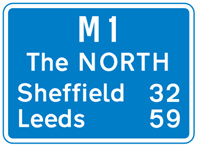
.PNG?width=250&height=152)
Source: Know Your Traffic Signs, Department for Transport, page 85
Top tip! Whenever you see a sign for motorway services, check the fuel and other gauges. If you drive past your exit by mistake, you must continue driving to the next exit. You must not stop on the motorway including the hard shoulder, drive against the traffic flow, or reverse.
Illuminated signals are used on motorways to advise of a range of hazards ahead. These include lane closures, poor weather conditions and traffic congestion. They may indicate that a lower speed limit is in force. Signals and variable speed limits apply to individual lanes when mounted overhead. Signals and variable speed limits the side of the motorway apply to all lanes.
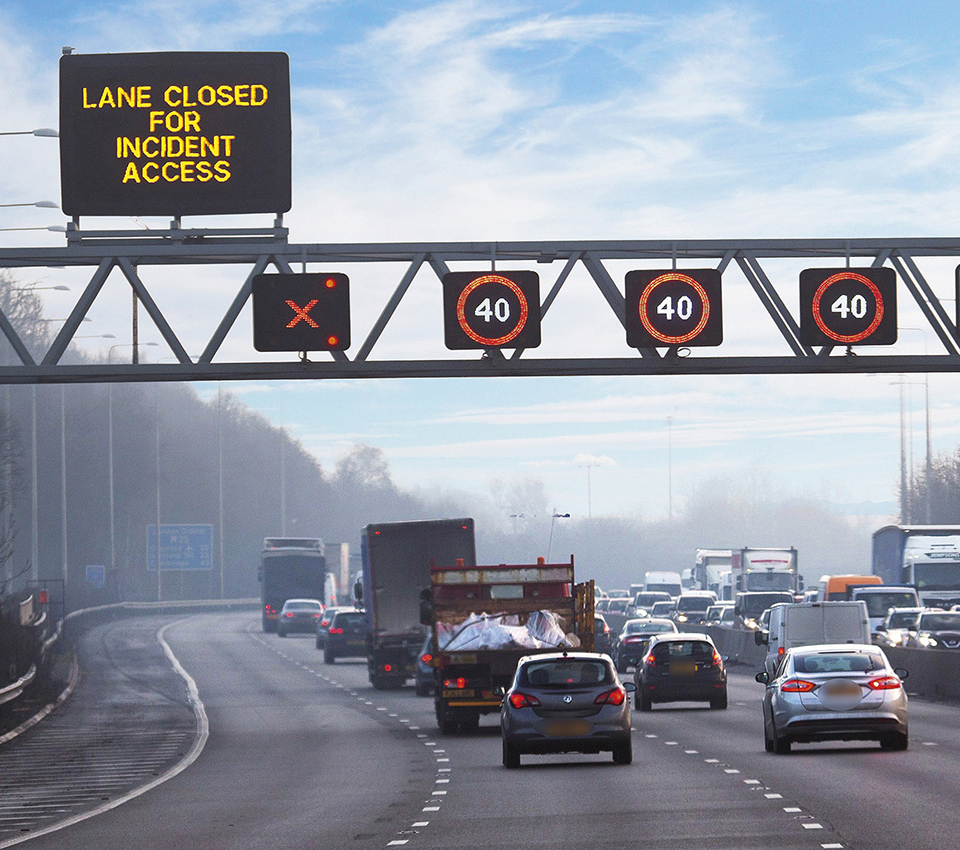.jpg?width=450&height=398)
Source: https://www.gov.uk/guidance/the-highway-code/motorways-253-to-273
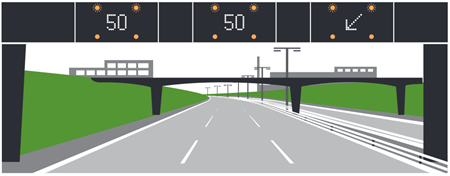
Source: Know Your Traffic Signs, Department for Transport, page 90
What road markings can I expect to see on the motorway?
Road markings on motorways are consistent with other roads in Great Britain. To assist with driving at night, coloured reflective studs are used to mark the lanes and edges of the road (image HC rule 132). White studs mark the lanes, red studs mark the left edge of the road and amber studs mark the central reservation of a dual carriageway or motorway. Green studs mark the edge of the main carriageway at slip roads and emergency refuges. Fluorescent green/yellow studs indicate temporary adjustments to lane layouts, for example where roadworks are being carried out.
What signs can I expect to see as I prepare to leave the motorway?
Motorway signs are designed to be as clear as possible to drivers travelling at speed. Like signs for service areas, signs for junctions are normally located one mile and half a mile before the junction. There will be markers counting down the last 300 yards before the start of the deceleration lane (first sign = 300 yards; second sign = 200 yards; third sign = 100 yards). Motorway junctions are numbered sequentially from the start of the motorway. The junction number is shown in a black square on the signs.
Top tip! Before you begin your journey, note the number of the junction you plan to leave the motorway. Signs might be located overhead or at the side of the motorway. At complex junction where lanes join or leave the motorway, they may show the arrangement of the traffic lanes.
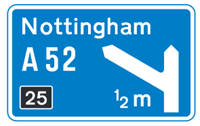
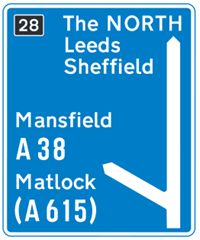
Source: Know Your Traffic Signs, Department for Transport, page 79
How do I leave the motorway safely?
If you’re in any other lane than lane one, move into lane one well before the junction you’ll leave the motorway. Signal your intention to leave the motorway in good time ie: no later than when you're passing the 300-yard marker. Once you’re on the slip road, try your brakes, which may not have been used for some time on a long motorway journey. Check your speedometer, as you may be travelling faster than you think. Slip roads can have bends that are unexpectedly sharp. Unless it links to another motorway, the slip road usually finishes at a junction.
Top tip! Before you begin your journey, check whether your destination is to the right or left of the junction.